Roads
A gateway to the North, Pangasinan is accessible through the following major thoroughfare: 1) Manila North Road; a north to south backbone that extends from Carmen, Rosales up to the Municipality of Sison; 2) the Romulo Highway via Tarlac; 3) the Pangasinan-Zambales Road (Olongapo-Alaminos-Bugallon road) connecting the province of Zambales in Region III; 4) Pangasinan-Nueva Ecija Road (Rosales-Umingan Road) which links Pangasinan to Nueva Ecija; 5) Pangasinan-Nueva Vizcaya Road (Rosales-Sta Fe, Nueva Viscaya), also known as the Villaverde trail; 6) Pangasinan-La Union Road, linking Pangasinan to province of La Union; and 7) Tarlac-Pangasinan-La Union Expressway (TPLEx);

The total road length of the province for the year 2018 is 8,250.3163 kms. National Road recorded 630.185 kilometers representing 7.64% of the total road length of Pangasinan, Provincial Road with 727.727 kilometers or 8.82%, Municipal Road with 464.5167 kilometers or 5.63%, and Barangay Roads which has the longest with 6,427.8876 kilometers or 77.91% share of the total provincial road length.
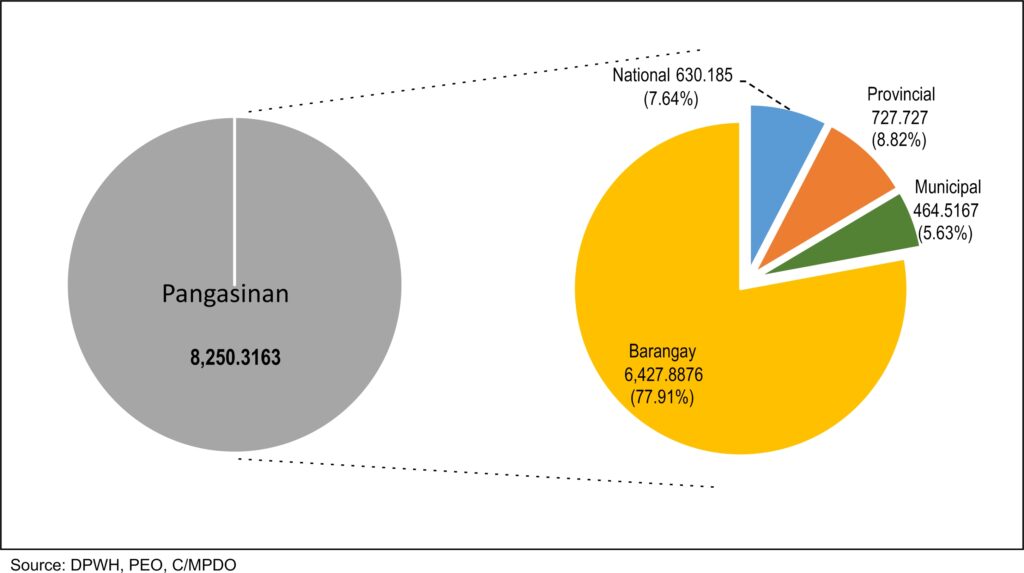
In terms of road density, Pangasinan has a road density of 1.51 km/sq.km of its total land area and 2.661 km/1,000 populations (2019 projected), which is still adequate compared to the standards of 1.0 km/sq. km. and 1km/1,000 population.
Bridges
The province’s total length of bridges is 36,968.0000 linear meters. National Bridges recorded the longest (by Administration) with a total of 14,107.2400 linear meters, which is about 38.16% of the total province’s bridge length. Provincial Bridges has 5,924.4000 linear meters or about 16.03%, Municipal Bridges with 3,480.9200 linear meters or 9.42%, and Barangay Bridges with 13,455.4400 linear meters or 36.40%.
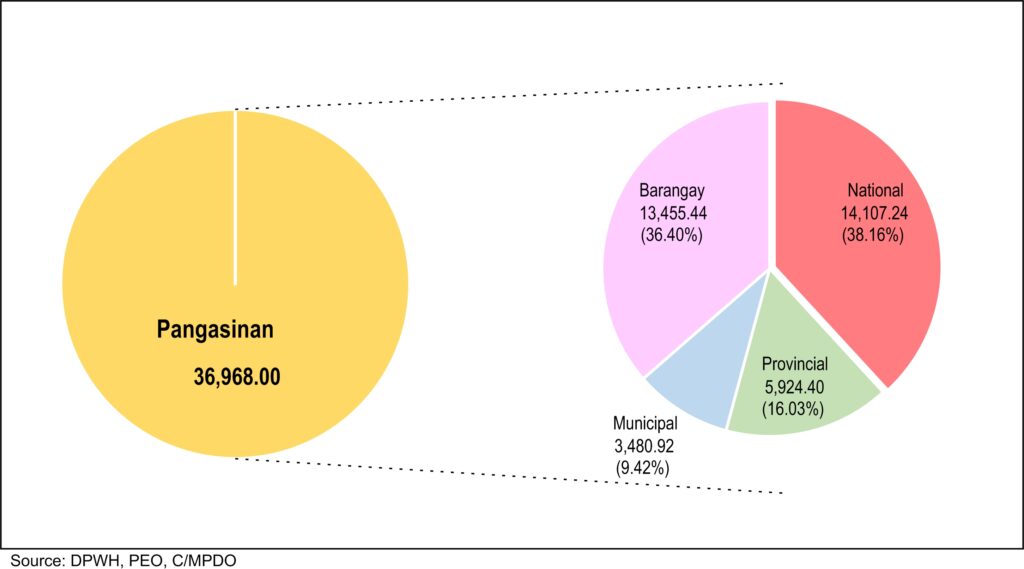
District VI has the longest bridge length with 9,030.77 linear meters or 24.43% of the total province’s bridge length, while District III has the least with 4,229.52 linear meters or about 11.44%.
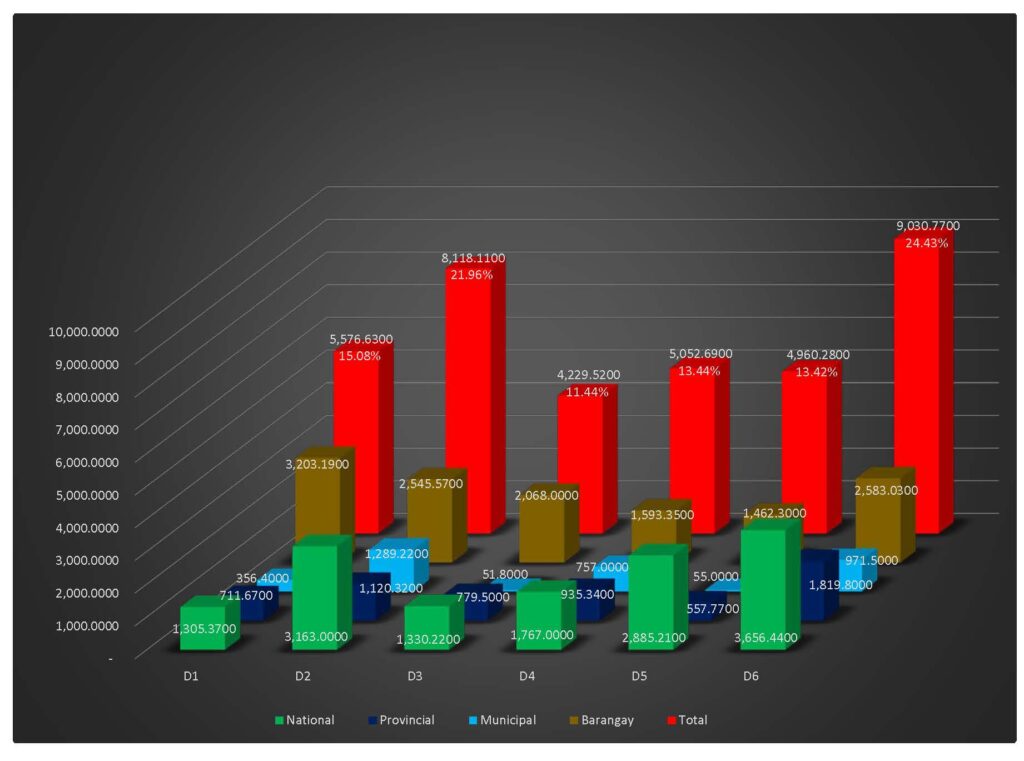
All national and provincial bridges are already made of permanent structures. Municipal and Barangay Bridges with permanent structures are recorded at 12,671.88 linear meters or about 75% of the total Municipal and Barangay bridge length, while the remaining 4,264.48 linear meters or 25% are still made up of temporary structures.
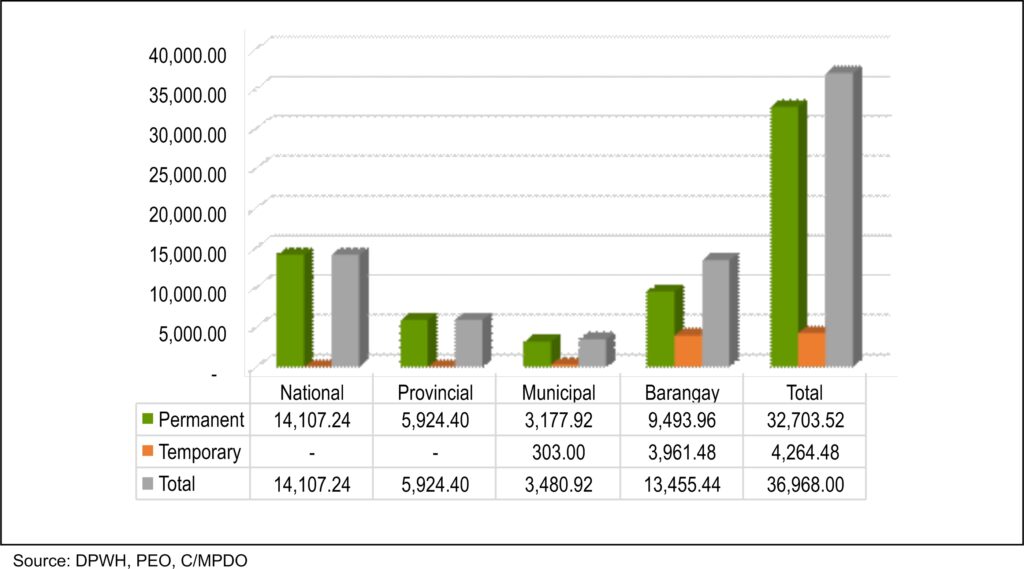
Irrigation System
For the year 2019, the irrigation coverage of the province was placed at 57% representing 105,662 hectares irrigated from the potential irrigable area of 185,542 hectares.
Domestic Water Supply
Potable water supply is being served by the 47 water districts/waterworks associations and privately-owned water associations located in different parts of the province catering to various clients namely; residential, commercial and industrial. Residential had the highest connections with 226, 434, an increase of 10.13% or 20,836 connections over the previous year’s figure of 205,598. Meanwhile, commercial and industrial/government had 14,002 and 2,360 connections, respectively.
Among the water service provider, Dagupan City Water District exhibited the highest residential connections with 22,724 consumers, followed by Alaminos City with 15,676 connections and Mangaldan with 13,006. In terms of water consumption for all types of client, Dagupan City Water District likewise registered the highest with a total of 6,716,883 cubic meters, followed by Alaminos City Water District with 4,458,575 cubic meters and Mangaldan Water District with 3,478,104 cubic meters.
Of the forty-eight (48) cities/municipalities of the province, five (5) municipalities (Aguilar, Labrador, Sison, Natividad and Bautista) have no existing water district or waterworks system within their municipality.
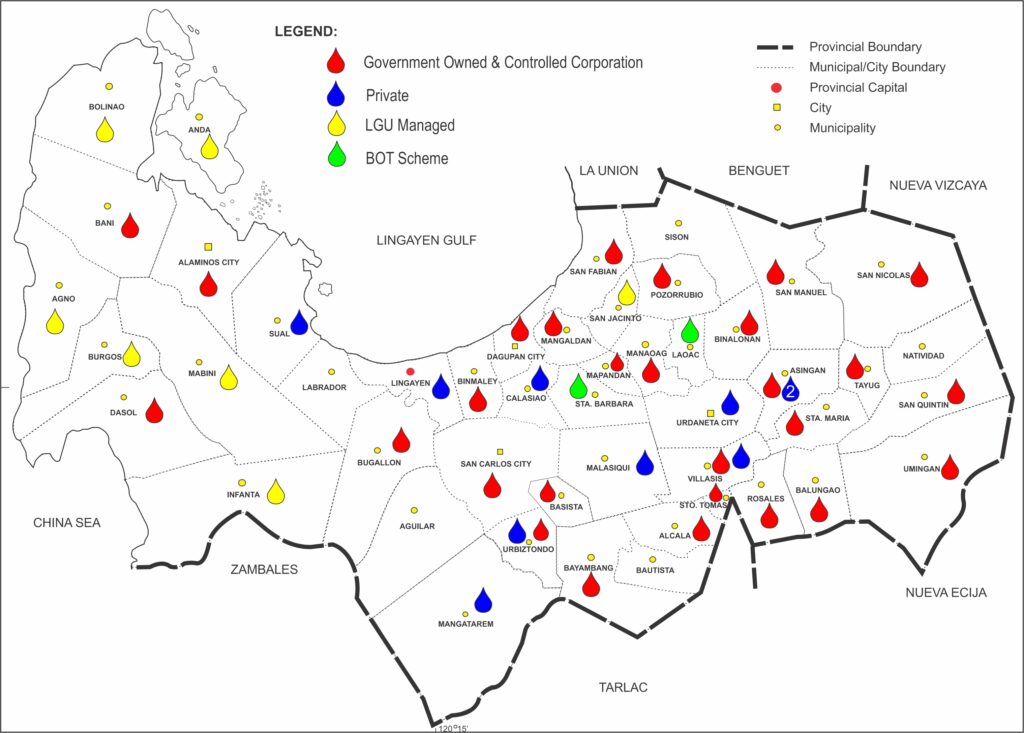
Electric Power Supply
100% of the barangays in Pangasinan have been energized. However, out of 685,009 potential household connections, some 669,963 or about 98% have been energized.
The province has 2 power generation plants, the Sual Coal-Fired Power Plant and the San Roque Hydro Power Plant located in the municipalities of Sual and San Manuel, respectively. These power plants have a combined generating capacity of 1,545MW and have several transmission lines carrying high voltage of 69 KV, 230 KV and 500 KV.
There are five (5) electric cooperatives providing electrical services in the province, namely: Pangasinan Electric Coops I and III (PANELCO I & III), Central Pangasinan Electric Coop (CENPELCO), Dagupan Electric Corporation (DECorp), and the La Union Electric Coop (LUELCO). The latter provides electrical services to some barangays of San Jacinto, San Fabian and Sison. The cost per kilowatt hour of the different Electric Cooperatives varies by type of consumers. For residential, PANELCO III has the highest rate/kwh with P10.44, followed by LUELCO and PANELCO I with Php10.14 and Php9.97, respectively.
As to consumption, household connections posted the highest consumption at 732,963,463 kwh, with an average consumption of 1,323 kwh per household. On the other hand, Street Light end users have the least number of connections registering a total consumption of 12,082,264 kwh.
Transport Facilities
A total of 276,414 motor vehicles were registered in CY 2019, which had increased by 10.42% or 26,082 vehicles compared to last year’s figure of 250,332 registered motor vehicles. By vehicle classification, private vehicles recorded the highest number of registration with 229,119 vehicles or about 82.89% of the total registered vehicles, followed by vehicles “for hire” with 45,944 vehicles or 16.62%, and government vehicles with only 1,351 vehicles or 0.49%.
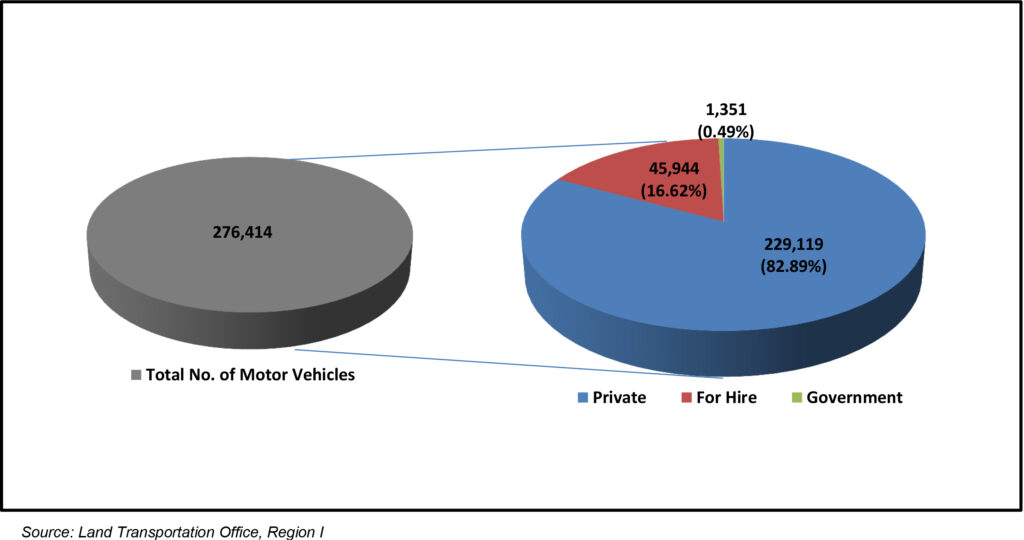
For the various types of motor vehicles, motorcycle/tricycle always posted the highest number of registration with this year’s 187,350 or almost 67.78% of the total number registered. This is followed by the utility vehicles with 46,623 or 16.87%, cars with 21,503 or 7.78%, sports utility vehicles with 11,443 or 4.14%, trucks with 8,779 or 3.18%, and trailers with 533 or 0.19%. Posted with the least registration are buses with only 183 or 0.07% of the total registered vehicles.
Out of the total registered motor vehicles, 219,065 or 79.25% are using gasoline, while 56,816 or 20.55% use diesel. Compared to last year’s data of 196,546 and 53,333 vehicles using gasoline and diesel, respectively, an increase of 11.46% and 6.53% respectively, was noted.
Communication Facilities
Postal services are being provided by the 50 post offices giving more than 100% coverage for the province. For the year under review, one (1) post office served 59,837 individuals. For the same period, there are 110 letter carriers in the province, serving 27,199 persons per letter carrier. The ratios of both the post office and the letter carrier to population are below the standard ratio of 1:6000 and 1:5000, respectively.
Also providing information services in the province are 19 print local publications, 12 existing cable stations and 14 broadcast/radio stations.
The province is fully served with telephone services provided by PLDT making it at 100% coverage. SACATEL also provides telephone services covering part of the City of San Carlos only. A total of 50,389 have been subscribing province wide, making a telephone density of 1.63 for every 100 persons for the year under review.
Solid Waste Disposal
In disposing of solid wastes, eleven (11) or almost 23% of the total number of municipalities/cities use the Controlled Dumpsite Facility and only four (4) use Sanitary Landfill Facility, namely: Bolinao, Burgos, Alaminos City, and Urdaneta City. The rest use open dumpsite, except for the Municipality of Sto.Tomas, which has no dumpsite, but has MRF in every barangay.
From the total number of barangays in the province (1,364), only 159 or 11.66% have Material Recovery Facilities (MRF), which is far behind the standard of 1 MRF for every barangay. In addition, thirty-six (36) Central MRF are established in some local government units in the province, which are funded by the National Solid Waste Management Commission (NSWMC), while one (1) is LGU-initiated (Bayambang). Only the municipalities of Bautista, San Nicolas and Sto.Tomas have 100% compliance in the establishment of MRF in every barangay.
Slaughterhouse
Among the forty-eight (48) municipalities/cities of the province, forty one (41) have existing slaughterhouse, which shows that seven (7) or 15% of the total number of local government units have no slaughterhouse.
Public Market
All the municipalities and cities of Pangasinan have their own public markets.
Ports
Based from the Philippine Ports Authority (PPA) data, the province has six (6) registered ports, of which, five (5) are temporary/non-commercial ports, which handle their own cargoes/products, and the Sual Government Port that handles commercial cargoes, but can only accommodate small vessels at present.
A total of 421 domestic and foreign ship calls were recorded at the various ports and anchorages in the province. More than half of which, or 211 vessels were reported to have called/arrived at the Team Sual Corporation, and 171 at the Sual Government Port.
The total volume of cargo discharged and loaded is 3,265,828 metric tons. Bulk of which is from Team Sual Corporation with 3,183,700 metric tons, while the remaining are from the Pryce Gases, Inc., Macroserve Mining, Inc., and Sual Government Port.


